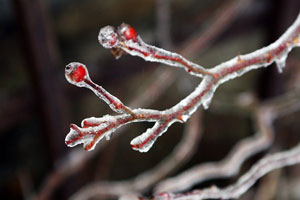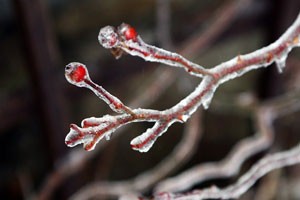
25 Mar Don’t Speed Up A Long Winter
 Let Late Season Winter Precipitation Run Its Course, Rather Than Causing Further Damage To Your Plants & Shrubs
Let Late Season Winter Precipitation Run Its Course, Rather Than Causing Further Damage To Your Plants & Shrubs
Even though spring has officially arrived, winter continues to drag on en route to one of the three snowiest years on record here in the Tri-State area.
And when a late winter/early spring snow and ice fall occurs, quite often a homeowner will attempt to remove such covering from plants and shrubs in order to allow them to begin spring growth.
Big mistake.
Plants and shrubs are generally quite resilient and can take up to half an inch of ice or a total covering of snow. Attempting to remove accumulation can often cause more damage than the ice or snow itself.
“We see more damage to beautiful landscaping when a homeowner attempts to speed along Mother Nature by removing ice and snow,” said Ralph Dinizo, President of Truesdale Nursery & Landscape Services of Berkeley Heights, N.J. “Most plants simply don’t like this.”
It Depends On The Plant
Plants with multiple stems, weak or damaged crotches or branches, as well as older specimens are most susceptible to damage.
One way to prevent damage to these plants is to tie the branches together until the snow and ice melt. Tie weaker branches to stronger ones. On plants with multiple leaders, such as arborvitae, you can tie the leaders together with strips of strong cloth or nylon stocking.
But always remember to remove these ties when you’re sure winter is officially over, as they can cause damage during the growing season.
However, if it’s necessary to remove excessive snow or ice, be very gentle and wait until temperatures are near the freezing mark, not when it is subzero. Running cold water can be used to remove ice an inch or more thick. Never use hot water, as this could kill the plant. And make sure the water does not re-freeze.
Also, don’t hit the plants with shovels or other tools to remove snow and ice! Instead, use a broom to gently remove snow, removing just enough to take pressure off the plant. You don’t need to remove all the snow or ice.
How To Handle Broken Branches
If branches do break, always make sure to remove them as soon as possible. Proper pruning assures healing and new growth each year. Cut broken branches back to their origin and not beyond the break, unless the break occurs right at the crotch. Make a clean cut and remove any damage.
And it’s always better to leave a wound open and clean rather than applying any type of paint to it.
Also, trees don’t heal, they rather grow over a damaged area. Which is why you must always remember to clean any damage diligently.
Take the time to protect your plants with tender care from the winter elements where necessary, and before you know it, you’ll be enjoying the fruits of your labor.


